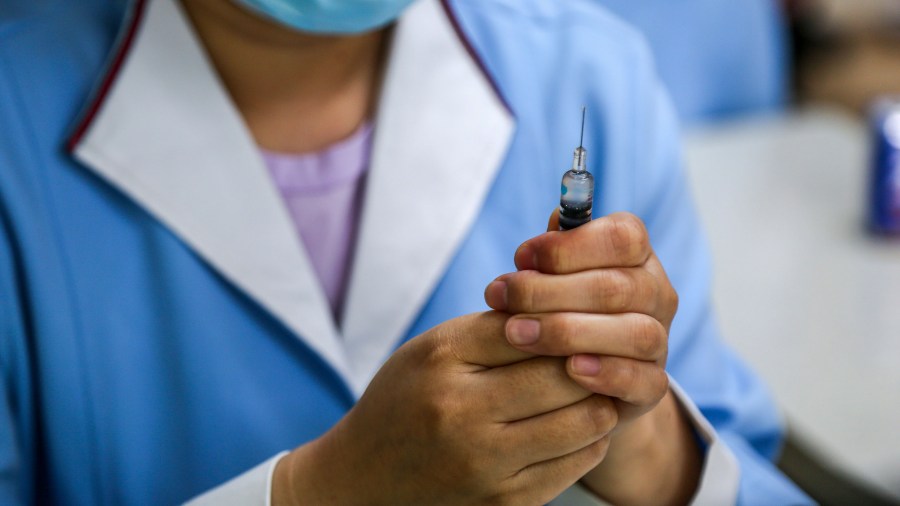The tech behind the search for a COVID-19 vaccine

This week on “Marketplace Tech,” we’re reporting on the innovations that will help us transition to a post-pandemic future. A lot of hopes are pinned on a vaccine for COVID-19. And there are a lot of efforts on that front. Some combine the old ways of making vaccines with new techniques.
“For hundreds of years, a vaccine was like, well, let’s take a dead piece of the bug and put it inside the body and the body’s immune system will figure out what to do,” said Safi Bahcall, a biotech investor and author of “Loonshots: How to Nurture the Crazy Ideas That Win Wars, Cure Diseases, and Transform Industries.”
The technique he’s talking about is how the first measles vaccines were created in the 1960s.
“The body’s immune system is sort of like sniffer dogs. You give a little taste of the virus, a little piece of the sweater or an old shoe, like a little fragment of the protein of the virus,” Bahcall said. “And then those antibodies go hunting around your blood and they start policing the blood for anything that smells like it and then attack it as soon as it comes into your blood.”
So that’s one method of creating a vaccine. Then, about 40 years ago, scientists added a different technique, where they would genetically engineer those virus proteins in a lab. That meant better quality control and a faster, safer, cheaper process.
These days, scientists use both of those methods to attempt to create a COVID-19 vaccine, along with another, much newer approach. It’s a little complicated.
“Suppose instead of manufacturing all these viruses, or protein fragments, or dead viruses and using that as a vaccine, suppose we skip that step,” Bahcall said. “And just take the code, the instructions, the [messenger] RNA or DNA for making that fragment, and give it to the body’s cells. So instead of having a giant lab in a warehouse cranking out these proteins that we then put into lots of vials and deliver billions of doses around the world, your own cells will be the manufacturing plant.”

While this technique has been around for 10 years, it hasn’t yet led to a successful vaccine for any disease. And that’s partly for lack of trying — or more precisely, lack of funding for vaccine research on viruses of all kinds. That’s holding us back now and could impact our ability to develop vaccines for future viruses, too.
“The problem is there hasn’t been enough incentive to work in infectious disease. SARS-CoV-1, which came out 18 years ago, the first sort of version of the SARS virus, is 80% genetically identical to the current SARS-CoV virus,” Bahcall said. “We had started some promising work and promising drugs and promising vaccines against that first SARS virus, some of which may have been enormously helpful.”
These days, there is plenty of incentive to both cure and treat COVID-19. And those efforts are happening in parallel, so that even by the time we get a vaccine, we might have much better success at preventing deaths from the virus. Bahcall likened it to HIV, where there’s no vaccine, but drug development has turned the virus from a fatal condition into a chronic one.
“Every month, we get more data about what drug works. It’s not just the exciting stuff of, hey, a scientist in the lab came up with this awesome new molecule that nobody ever saw before, and it eradicates the virus on first contact. That’s not how it works,” Bahcall said. “Sometimes it’s like, well, a pretty boring old drug that none of us thought mattered very much actually works. Or the right combination: by itself, it’s OK, but if you combine A and B, it’s really amazing. Those don’t make sexy headlines, but they’re really important.”
So, despite all the very bad headlines, Bahcall said he’s feeling positive.
“One of the reasons that I’m optimistic is just the number of shots on goal that we have. And for most diseases, maybe you develop five drugs or 10 drugs in clinical trials. Today, we have over 300 treatments in development for COVID-19. Those of us working in the industry, we’ve never seen anything like this,” Bahcall said.
Related links: More insight from Molly Wood
Like Bahcall said, while the vaccine development and innovation is astonishing, the treatment question is also fascinating. In fact, the doctor who invented the drug cocktail that turned the tide in the fight against AIDS is leading a team of researchers at Columbia University Irving Medical Center. They published the results of studies just last week in the journal Nature in which they used a cocktail of antibodies to treat COVID-19 extremely effectively. They said the antibodies could even be used to prevent infection, especially in the elderly. Dr. David Ho, who’s leading the team, said the cocktails are ready to be developed into treatments.
The future of this podcast starts with you.
Every day, the “Marketplace Tech” team demystifies the digital economy with stories that explore more than just Big Tech. We’re committed to covering topics that matter to you and the world around us, diving deep into how technology intersects with climate change, inequity, and disinformation.
As part of a nonprofit newsroom, we’re counting on listeners like you to keep this public service paywall-free and available to all.
Support “Marketplace Tech” in any amount today and become a partner in our mission.


















